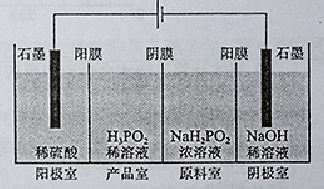(15分)
次磷酸(H3PO2)是一种精细化工产品,具有较强还原性,回答下列问题:
(1)H3PO2是一元中强酸,写出其电离方程式:
(2)H3PO2及NaH2PO2)均可将溶液中的银离子还原为银单质,从而可用于化学镀银。
①(H3PO2)中,磷元素的化合价为
②利用(H3PO2)进行化学镀银反应中,氧化剂与还原剂的物质的量之比为4︰1,则氧化产物为: (填化学式)
③NaH2PO2是正盐还是酸式盐? 其溶液显 性(填弱酸性、中性、或者弱碱性)
(3)(H3PO2)的工业制法是:将白磷(P4)与氢氧化钡溶液反应生成PH3气体和Ba(H2PO2),后者再与硫酸反应,写出白磷与氢氧化钡溶液反应的化学方程式:
(4)(H3PO2)也可以通过电解的方法制备。工作原理如图所示(阳膜和阴膜分别只允许阳离子、阴离子通过):

①写出阳极的电极反应式
②分析产品室可得到H3PO2的原因
③早期采用“三室电渗析法”制备H3PO2,将“四室电渗析法”中阳极室的稀硫酸用H3PO2稀溶液代替,并撤去阳极室与产品室之间的阳膜,从而合并了阳极室与产品室,其缺点是 杂质。该杂质产生的原因是:
(1)H3PO2 H++H2PO2-;(2)①+1;②H3PO4;③正盐 弱碱性;
H++H2PO2-;(2)①+1;②H3PO4;③正盐 弱碱性;
(3)2P4+3Ba(OH)2+6H2O=3Ba(H2PO2)2+3PH3↑;
(4) ① 2H2O-4e-=O2↑+4H+;②阳极室的H+穿过阳膜扩散至产品室,原料室的H2PO3-穿过阴膜扩散至产品室,二者反应生成)③ PO43-;H3PO3或H2PO2-被氧化。
题目分析:(1)由于H3PO2是一种中元强酸,所以其电离方程式是H3PO2 H++H2PO2-;(2)①根据化合物中正负化合价的代数和为0,H是+1价,O是-2价。所以在H3PO2中P元素的化合价为+1价。②根据题意结合电子守恒、原子守恒可知:氧化产物为H3PO4,还原产物是Ag。③根据元素的化合价及电离情况可知H3PO2的结构是
H++H2PO2-;(2)①根据化合物中正负化合价的代数和为0,H是+1价,O是-2价。所以在H3PO2中P元素的化合价为+1价。②根据题意结合电子守恒、原子守恒可知:氧化产物为H3PO4,还原产物是Ag。③根据元素的化合价及电离情况可知H3PO2的结构是 ,所以NaH2PO2是正盐;由于该盐是强碱弱酸盐,所以该溶液显弱碱性。(3)根据题意可得白磷与氢氧化钡溶液反应的化学方程式是2P4+3Ba(OH)2+ 6H2O= 3Ba(H2PO2)2 +3PH3↑;(4)①在阳极由于含有的阴离子OH-、SO42-、H2PO2-中放电能力最强的是OH-,所以发生反应: 2H2O-4e-=O2↑+4H+;②在产品室只所以可得到H3PO2是因为阳极室的H+穿过阳膜扩散至产品室,原料室的H2PO3-穿过阴膜扩散至产品室,二者反应生成)③早期采用“三室电渗析法”制备H3PO2,将“四室电渗析法”中阳极室的稀硫酸用H3PO2稀溶液代替,并撤去阳极室与产品室之间的阳膜,从而合并了阳极室与产品室,其缺点是阳极产生的氧气会把H3PO3或H2PO2-氧化为PO43-,是产品不纯。
,所以NaH2PO2是正盐;由于该盐是强碱弱酸盐,所以该溶液显弱碱性。(3)根据题意可得白磷与氢氧化钡溶液反应的化学方程式是2P4+3Ba(OH)2+ 6H2O= 3Ba(H2PO2)2 +3PH3↑;(4)①在阳极由于含有的阴离子OH-、SO42-、H2PO2-中放电能力最强的是OH-,所以发生反应: 2H2O-4e-=O2↑+4H+;②在产品室只所以可得到H3PO2是因为阳极室的H+穿过阳膜扩散至产品室,原料室的H2PO3-穿过阴膜扩散至产品室,二者反应生成)③早期采用“三室电渗析法”制备H3PO2,将“四室电渗析法”中阳极室的稀硫酸用H3PO2稀溶液代替,并撤去阳极室与产品室之间的阳膜,从而合并了阳极室与产品室,其缺点是阳极产生的氧气会把H3PO3或H2PO2-氧化为PO43-,是产品不纯。
